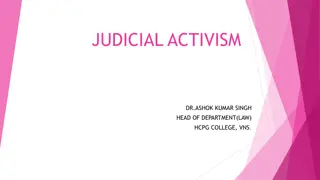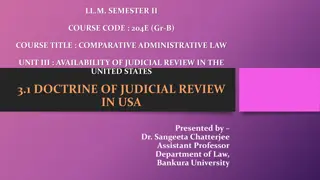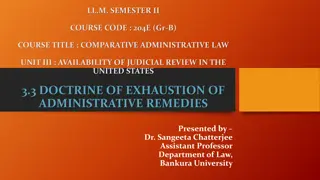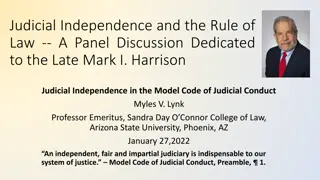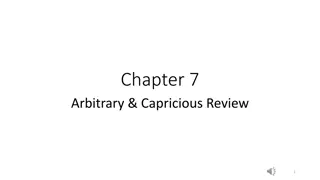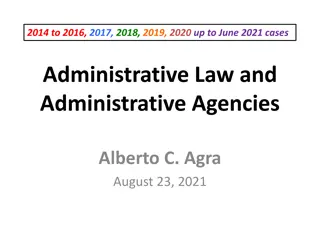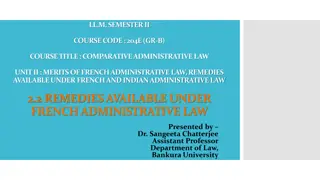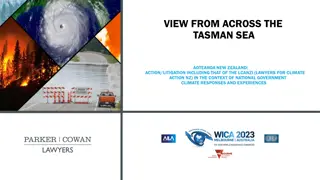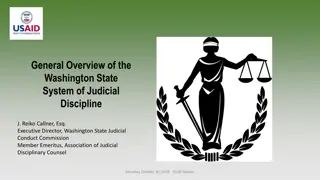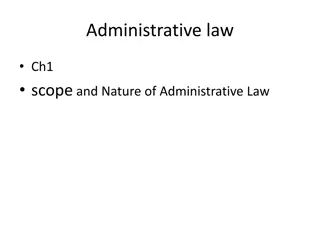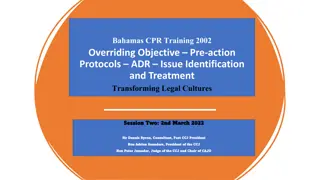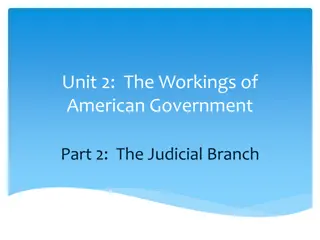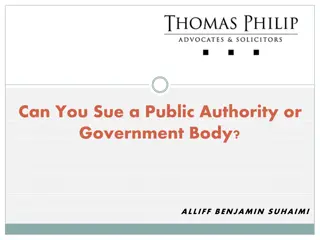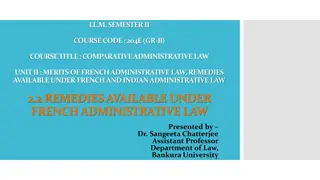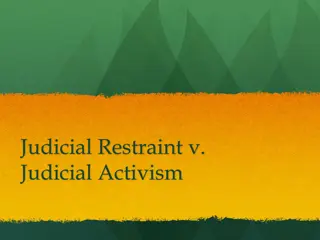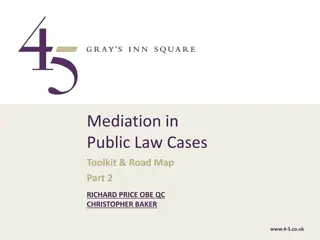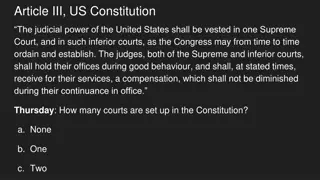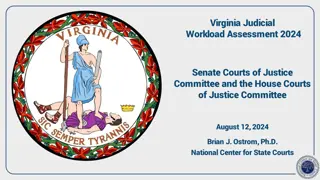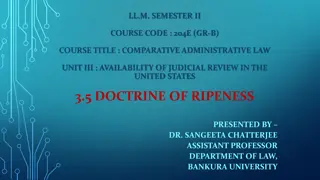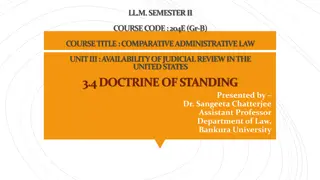Understanding Judicial Review in Administrative Law
In this chapter, the concept of judicial review in administrative law is explored, focusing on the scope of review set by Congress, including trial de novo and independent judgment on evidence. Different standards of review, such as clearly erroneous and substantial evidence, are discussed, highlighting their application in formal and informal adjudications and rulemaking. The chapter emphasizes the importance of determining if agency decisions are arbitrary or capricious, providing a comprehensive overview of judicial review processes.
Download Presentation

Please find below an Image/Link to download the presentation.
The content on the website is provided AS IS for your information and personal use only. It may not be sold, licensed, or shared on other websites without obtaining consent from the author. Download presentation by click this link. If you encounter any issues during the download, it is possible that the publisher has removed the file from their server.
E N D
Presentation Transcript
Chapter 7 Part III
Chapter 7 Judicial Review of Facts Determined by the Agency
Scope of Judicial Review of Facts Congress sets scope of review, within constitutional boundaries. Since the Constitution is silent on agencies, Congress has wide latitude. Congress can allow anything from a trial de novo to no review, unless such an action otherwise runs afoul of the constitution. 3
Trial De Novo You start over at the trial court Agency findings can be used as evidence, but there is no deference to the agency FOIA Used more by the states than the feds 4
Independent Judgment on the Evidence Decide on the agency record, but do not defer to the agency's interpretation of the record. 5
Clearly Erroneous Definite and firm conviction that a mistake has been made on the facts or policy Same as reviewing a verdict by a trial judge without a jury 6
Substantial Evidence - Formal Adjudications 706(2)(E) - only applies to formal adjudications and formal rulemaking Could a reasonable person have reached the same conclusion? Standard for reviewing a jury verdict or for taking a case from the jury Should a jury get more or less deference than an agency? Hint - substantial means some, not a lot, when you are the agency 7
Substantial Evidence - Informal Adjudications and Rulemaking 706(2)(A) Arbitrary and capricious or abuse of discretion Same assessment of reasonableness as 706(2)(E), so the result is about the same as the substantial evidence test used for formal proceedings This is the most common standard 8
Substantial Evidence - Universal Camera v. NLRB, 340 US 474 (1951) it is such relevant evidence as a reasonable mind might accept as adequate to support a conclusion ; it is evidence sufficient to withstand a motion for a directed verdict. It is a less rigorous standard than clearly erroneous, the standard by which appellate courts review factual findings made by a trial judge. It is more rigorous than no basis in fact. The agency s findings are entitled to respect, but they must nonetheless be set aside when the record before a [court] clearly precludes the [agency s] decision from being justified by a fair estimate of the worth of the testimony of witnesses or its informed judgment on matters within its special competence or both. . . . 9
Some Evidence Scintilla test The agency needs to show even less than in the substantial evidence standard Only limited use 10
Facts Not Reviewable At All Congress can prevent certain types of judicial review Compensation decisions under the Smallpox Vaccine Compensation Act are not reviewable Enabling law is always reviewable unless Congress has taken away the court's subject matter jurisdiction. 11
Federal Agency Review of ALJ Decisions Assume there is a hearing before an ALJ, the ALJ prepares a recommended opinion, and the agency wants to overrule the ALJ. May the agency substitute its decision for that of the ALJ? Why is the agency in a different position than the court when reconsidering an ALJ decision? What must the agency do when it wants to overrule an ALJ? Why is this different in Louisiana? 12
Agency Deference to the ALJ Why are witness credibility decisions by the ALJ difficult for an appeals panel to reevaluate? Why are ALJ legal findings entitled to the least deference by the agency? Deference to scientific or technical findings by the ALJ will depend on the expertise of the reviewing board members and their staff. 13
NLRB Smoking Hypo Employee says he was fired for union activity and the company says it was for violating the smoking policy. ALJ record shows employee was smoking but supervisor claimed this as excuse to fire him for his union activity. There is conflicting testimony from several witnesses, and the ALJ resolves these in favor of the company. 14
NLRB Board Review Board sees this as typical union harassment case. Board does not believe that supervisor was unaware of employee s union activity. If you are representing the employee before a court contesting the action, what are your arguments? What if there was evidence of a strictly enforced anti-smoking policy? 15
OLeary v. Brown-Pacific-Maxon, 340 U.S. 504 (1951) Was a worker within course and scope of employment when he drowned trying to save a foundering swimmer? Were there any disputed facts about the accident? What do you need to determine for a course and scope decision? Is it purely legal? Is this a legal question, entitled to less deference, or a factual one, entitled to more deference? 16
Frankfurters Hybrid Decision Analysis [This] only serves to illustrate once more the variety of ascertainments covered by the blanket term fact. Here of course it does not connote a simple, external, physical event as to which there is conflicting testimony. The conclusion concerns a combination of happenings and the inferences drawn from them. In part at least, the inferences presuppose applicable standards for assessing the simple, external facts. Yet the standards are not so severable from the experience of industry nor of such a nature as to be peculiarly appropriate for independent judicial ascertainment as questions of law. 17
NLRB v. Bell Aerospace Co., 416 U.S. 267 (1974) Company refuses to collectively bargain with buyers, saying they are managers. Agency finds that only managers whose interests align with the company are exempted from unionization. The court overruled the agency, holding that the law exempted all managers. Why no substantial evidence review and Hearst/ Chevron deference? How might the agency still get deference on the remand to determine whether buyers are managers? 18
Chapter 7 A & C Review
Cabining Arbitrary and Capricious Review Old definition Highly deferential to the agency Same as rational relationship test in constitutional law Citizens to Preserve Overton Park, Inc. v. Volpe, 401 U.S. 402 (1971) Added the notion of looking at the administrative record before the agency a substantial inquiry, a thorough, probing, in- depth review, and [a] searching and careful [inquiry into the facts]. 20
When Should the Court Allow the Record to be Supplemented by the Agency? This would result in de novo review of the new material Like a trial transcript on appeal, the record is usually closed. There can be an exception if the issue being appealed to the courts is the agency's failure to allow outside input and thus failing to consider all relevant factors. The court can allow the new material and give the agency a chance to supplement its record in response. There can also be an exception if the plaintiff makes a credible showing of significant bias by the agency and the court needs to evaluate it. The court can ask the agency to appoint an ALJ to take evidence and present it to the court - RARE 21
"Hard Look" - National Lime Assn. v. EPA, 627 F.2d 416, 453 (D.C. Cir. 1980) [judicial review should] evince a concern that variables be accounted for, that the representativeness of test conditions be ascertained, that the validity of tests be assured and the statistical significance of results determined. Collectively, these concerns have sometimes been expressed as a need for reasoned decision- making. . . . However expressed, these more substantive concerns have been coupled with a requirement that assumptions be stated, that process be revealed, that the rejection of alternate theories or abandonment of alternate course of action be explained and that the rationale for the ultimate decision be set forth in a manner which permits the . . . courts to exercise their statutory responsibility upon review. 22
Hard Look at What? The courts cannot use hard look to change the underlying requirement that they defer to agency decisionmaking on facts and policy. Hard look analysis requires agencies to make sure that the record for the case provides a clear basis for their factfinding and their policy decisions. The federal court cannot change the decision, but it can require the agency to provide better support for its decisions. Hard look drove rulemaking ossification. 23


